How to properly propagate a sheffler at home?

There is an inextricable link between man and nature. Communication with nature gives a charge of cheerfulness, saturates with positive energy. Man has long invented a way to preserve a particle of nature nearby. This is the way to keep flowers at home. Schefflera is one of the most beloved plants by flower growers.

Views
There are many types of shefflera, representatives of the genus of which are trees, shrubs, vines. All shefflers are from Southeast Asia. The species and varieties related to them have received one name due to the unusual shape of the leaves of a certain color. Scheffleroy plants are named after the German botanist Jacob Christoph Scheffler, who lived in the 18th century and devoted his scientific works to the study of all species of this plant.

In nature, sheffler grows to incredible height, flowering buds have reddish-purple hues. To accommodate shefflers in homes, flower growers select varieties of small sizes. The most popular of these are:
- liana;
- radiant;
- finger;
- the most graceful.
At home, the sheffler almost never blooms. Its main advantage in decorating the interior of the house is the unusual shape of the leaves, their beautiful color and rich color.

The listed types have their own characteristics.
- Scheffler liana. Homeland - the island of Taiwan. Houseplants have a long, thin stem that needs support. In the wild, the Schefflera liana is found in the forest mountains, therefore it does not like hot rooms. Feels comfortable at temperatures not higher than +17.19 degrees in summer and not lower than +13 degrees in winter. Different types of this plant have their own color of leaves. The most beautiful green is considered to be green with golden yellow spots, called variegated. Does not tolerate direct sunlight.
- Schefflera radiant. Arboreal, thermophilic. It grows in New Zealand, Australia, as winter temperatures in those places do not drop below +13 degrees. At home, it grows in the form of a bush with finger-like leaves of dark green color on tall cuttings. The tips of the leaves have a pointed shape, hence the name of this species.
- Schefflera finger. At home, it looks like a low tree with leaves shaped like fingers. The color of the leaves can be light green or dark green. Some varieties of this species have variegated leaf color. Like the others, the finger sheffler can be pinched to create a beautiful shape.
- Schefflera is the most graceful. This species has a delightful coloration. Against the background of the pale gray edge of the leaves and the same color of the central line, bright crimson stripes sparkle. To preserve the color of the leaves, the plant should be placed in a bright place, but not exposed to sunlight.


When is the best time to propagate?
It is not too difficult to breed a sheffler at home - you need to familiarize yourself with the rules of floriculture in more detail. Breeding is best done in early spring, when the plant comes out of dormancy and begins to "revive" - this is the time when the vital energy of the plant is directed to "reproduce offspring."


Preparation
In early spring, an adult houseplant is pruned to accelerate the appearance of young shoots in the field, which are later used as cuttings. When leaves are formed on young shoots, you can use them for reproduction. The necessary tools are purchased in advance, the soil mixture is selected, it is necessary to have auxiliary agents in the form of activated carbon and a plant growth regulator.

Breeding Exercise
Before planting a sheffler at home, it is recommended to heed the advice of experienced florists. You need to know how to dive seedlings of seedlings correctly, after what time it can be planted in a regular pot and how to care for a young plant. Most often, the sheffler is propagated by layers, seeds, leaves and cuttings. To obtain the initial planting material, 3 types of cuttings are used - green, semi-lignified and lignified.
Cuttings not used on the same day can be kept in water for a while.

Layers
A step-by-step guide to breeding shefflers by layering.
- Make a small incision in the lower part of the stem of the plant.
- Coat the incision with growth regulator with a small, clean brush.
- Insulate the area with moss, securing it with cling film.
- Important! Make sure that the moss is constantly moist. After about 3 weeks, the root will "hatch" on the cut.
- Cut the bark section from below together with the root, place in a container with the soil mixture with the root down, sprinkle with a thin layer of the mixture.
- To preserve moisture, place the container in a plastic bag or cover with glass, to prevent complete evaporation of moisture. Air every day for 15 minutes.
- When leaves are formed on the sprout, transplant into a regular pot.

Seeds
This type of breeding shefflera at home is available even for a novice florist. When choosing seeds, attention is paid to their quality and shelf life. The order of work:
- the prepared container is filled with soil mixture, slightly compacted and well moistened;
- seeds are distributed on the soil surface, trying not to create crowding;
- cover the container on top with glass and put it in a semi-dark place, make sure that the soil does not dry out;
- when seedlings appear (6-10 days), the glass is removed, the seedlings are exposed in a bright place without direct sunlight;
- grown seedlings dive with a spoon, trying not to damage the fragile roots.
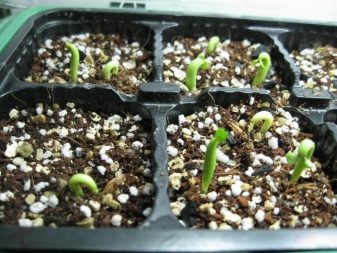
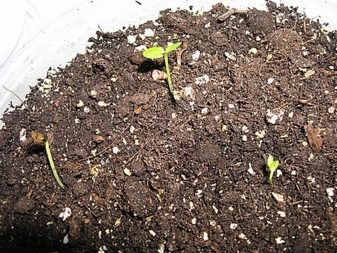
Sheet
This is not the easiest way to breed shefflers at home and requires patience.
- The leaf is separated from the adult plant, being careful not to damage the cutting.
- Place the leaf, handle side down, in a small jar of water. In this case, only the cutting of the leaf should be covered with water.
- Install the jar in a plastic bag, put it away in a dark place. The water is changed periodically.
- When a white sprout appears on the foot of the leaf, the leaf is carefully planted in a pot of damp potting soil.

Cuttings
It is possible to root the stem cutting at home with favorable conditions within one to several weeks. Cutting green shoots of a plant is considered the most correct solution.
- It is necessary to cut the shoot under the bud, then the lower leaves are removed. 3-4 leaves remain on the handle.
- Without touching the cut with your hands, treat it with a growth regulator and sprinkle with crushed coal.
- The stalk is placed in moist soil with a certain composition for a third of its length. Slightly compact the area around.
- Roots form faster in a warm room with a temperature of +23.26 degrees.
- Until fully consolidated in the soil, the stalk is watered every day.
Growing plants obtained as a result of such propagation methods are no different from adult specimens. They will become a worthy interior decoration, will help in the implementation of the idea of a floor composition, and will add warmth and comfort to the house.

Care advice
Rooting and keeping shefflers at home does not require special care, provided that the basic rules of care are followed.
Watering
With a lack of moisture, the small hair roots adjacent to the walls of the container dry up, and the plant gets sick. Leaves turn yellow, dry up and fall off. The plant's need for water is determined by the top layer of the soil; it should become dry no more than 1 centimeter deep. It can be determined by tapping on the pot - a container with wet soil makes a dull sound, a container with dry earth makes a sonorous sound.
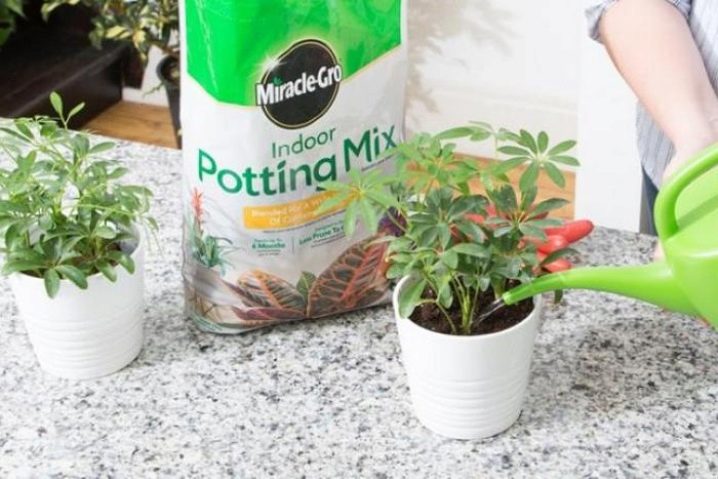
The plant can also ache from too much moisture. Too wet soil "does not breathe", plant roots do not receive oxygen and die. The symptoms of the disease are the same as from a lack of moisture, but an unpleasant sour smell begins to emanate from the soil, and sometimes the smell of ammonia appears. In this case, the sheffler should be removed from the container, cut off the decayed roots and planted in a pot with fresh soil, be sure to pour a layer of gravel on the bottom.

Transfer
Sheffler is transplanted once a year. The plant is removed from the container, the roots are examined. If a root plexus has formed in the lower part in the form of a coma, it is cut off, and the plant is transplanted into a larger pot. You cannot transplant the flower immediately after watering, you must let the water soak well. Before planting, drainage is created at the bottom of the new container. The top layer of earth is poured 2 centimeters below the edge of the pot; the root collar of the plant should not be covered with earth.
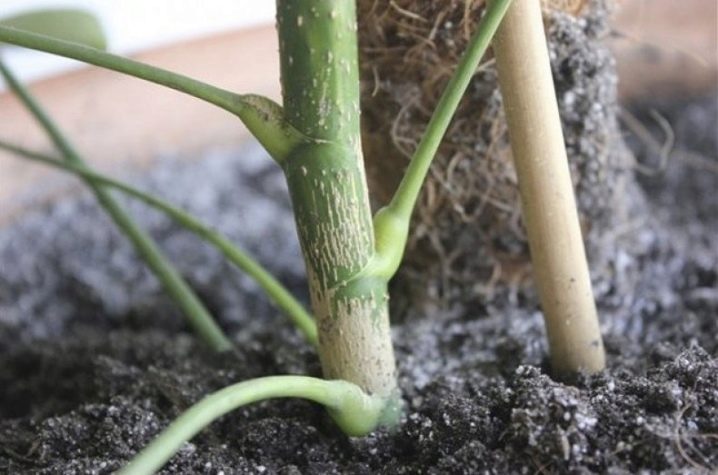
Pinching
To grow a beautiful bush-shaped plant, there is pinching and pruning. After pinching the tops of the sheffler, lateral branches begin to appear. In order for the development of the branches to be uniform, the plant is periodically turned to the sun in different directions.
Pruning
After the formation of a beautifully shaped bush, the shoots growing inward must be cut out. In early spring, general pruning of the plant is done, removing dried and weak branches. For pruning, a sharp pruner is used, the sections of the cuts are sprinkled with crushed coal.

Hygiene
Indoor plants need to be periodically cleaned of dust, which does not allow sunlight to pass through and clogs the pores. Small shefflers can be washed under the shower in the bathroom. On large flowers, dirt is removed with a sponge and a damp cloth; heavily soiled leaves are wiped with soapy water. Soap is an excellent preventive measure against pests and monthly use is encouraged.

Pests
A number of cases of sheffler diseases associated with the introduction of infection by new plants have been noted. Green aphids, thrips, red spiders are parasites that suck the juices from the delicate stems and leaves of plants. There is also a shaggy white aphid, similar to poplar fluff, gnawing a plant.
There are several methods of pest control. Visible aphids are removed with tweezers, immediately wiping the area with a solution of soap or kerosene to destroy testicular deposits. An effective means of getting rid of parasites is considered to be an infusion of makhorka (2 teaspoons per 1 glass of water).

You can use the fumigation method to combat parasites. The plant is placed under a hood, a lot of smoke is blown in with the help of a straw and left for several hours. Dead pests are removed from the flower and burned. And also to get rid of parasites, a soap-kerosene solution is prepared, which includes 100 grams of soap and 200 grams of kerosene. The mixture is stirred until thick sour cream, 6 liters of water are added, mixed well, and shefflers are sprayed with this solution.
Plants are sprayed 2-3 times, since the testicles of parasites may remain intact, from which new pests will appear after a while.
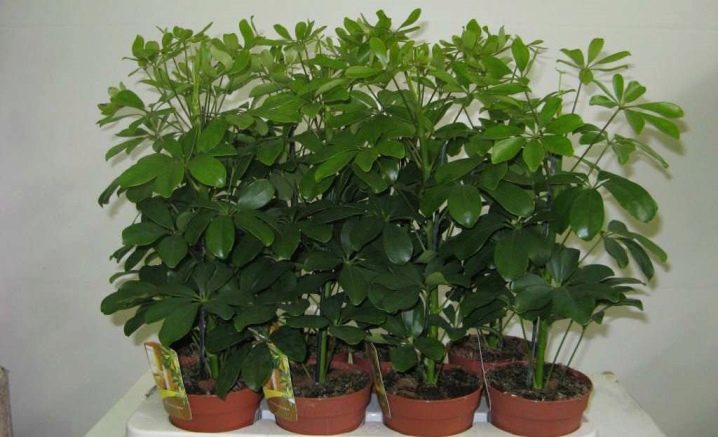
Home first aid kit for flowers
For timely intervention and elimination of the causes of diseases of domestic plants in the house it is recommended to have a special first aid kit with the necessary tools and means:
- garden shears, pruning shears, tweezers;
- spray bottle, brush, watering can, sponge;
- activated carbon, soap, iron vitriol, tobacco dust, sulfur;
- plant growth regulator.
All of the above is placed in a box with a lock, which should be out of the reach of children. When the first signs of a plant disease are detected, these funds will help to timely cope with the problem that has arisen.
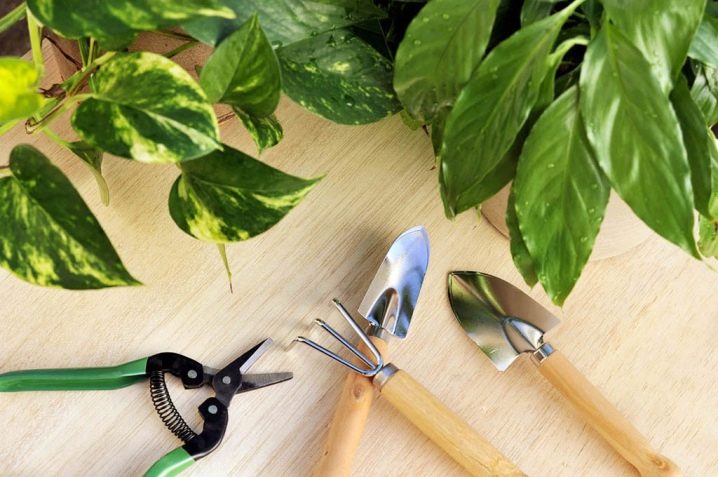
For breeding shefflers, see the video below.



























The comment was sent successfully.